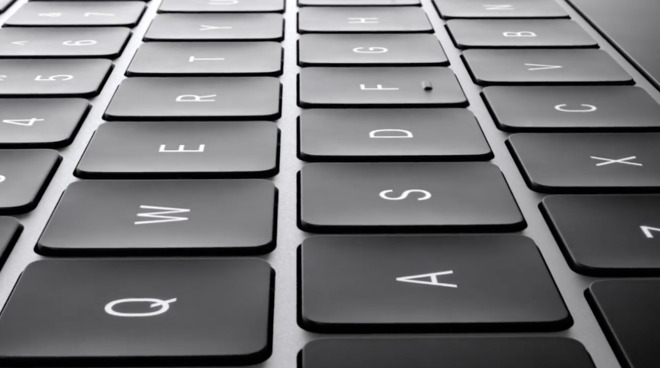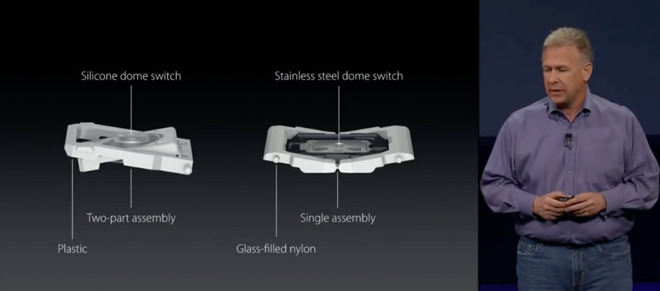Initial failures of Apple's butterfly keyboard doomed it from the start
Apple's "bold" butterfly keyboard will not be missed, but it's a bit unfair to scorch the earth behind it -- and there's a strong case for buying a 2019 model MacBook Air, or MacBook Pro.

Appel's butterfly keyboard introduced larger key caps
Apple has had more than its fair share of products that are adored, and possibly just about as many that are abhorred. Yet before you dismiss the butterfly keyboard as being a product nobody ever liked, remember where it came from.
The butterfly mechanism keyboard was introduced with the 2015 MacBook -- and that was beloved. When Apple discontinued it in 2019, nobody praised them for abandoning a butterfly keyboard machine, they lamented that Apple was abandoning us by taking it away.
But, we're not here to praise the butterfly keyboard. We're definitely not here to praise Tim Cook's initial introduction of it.
"We challenged ourselves to take everything that we had learned in designing iPhone and iPad," he said, "and do something incredibly ambitious and bold."
And we are here, though, to examine how reports of its failings were true, but exaggerated. No question, if that keyboard went wrong for you, it went badly wrong and the machine -- MacBook, MacBook Air, or MacBook Pro -- became immediately unusable.
And no question, AppleInsider proved that keyboard failures were higher for this early design.
Then, too, there is no question either that there were an awful lot of news stories about these failures, or that Apple introduced repair programs that launched right alongside the products they were repairing.
And in 2020, writer/director Taika Waititi really summed up a lot of ill-feeling when he lambasted Apple for all its keyboards over recent years.
More people said that their keyboards broke than they said they didn't like the feel of them. There were plenty of people who preferred older MacBooks for their keyboards, but plenty enough liked typing on the new one.

Phil Schiller explaining the difference between the old scissor system and the new butterfly one in 2015
"This butterfly mechanism is built of a single assembly and it's supported by a stainless-steel dome switch," said Phil Schiller at the launch. "And that all adds up to a key that is much more precise and accurate. In fact it's four times more stable than that scissor mechanism."
"Yet it is 40% thinner, allowing us to make a thinner keyboard," he continued. "And we also made the key cap larger, making it even easier to strike and get a beautiful typing experience."
The thinness is true, doubtlessly the greater stability is too. Schiller went on to report that Apple made the key caps 17% bigger, "making it even easier to strike and to get a beautiful typing experience," and we don't doubt him.
With the benefit of hindsight, however, we do question one of his enthused comments. Explaining how the old-style scissor mechanism worked, he said "and there was a time when that was great, but now there's something new."
Apple could make it sound as if this was something new, instead of it being an about face. Apple could move forward without admitting that the butterfly mechanism hadn't worked. And without announcing to lawyers that for five years it had been selling a keyboard it now called broken.
Regardless of the name or the presentation, though, as soon as that 16-inch MacBook Pro came out, two things happened. Everyone crossed fingers that the new keyboard would come to the rest of the range. And suddenly the noise of the old butterfly mechanism became more discussed.
But still, there is discussion, there is anecdote -- and there are the facts.
That means it's not possible to make one overall statement about the reliability of the butterfly keyboard, but then AppleInsider didn't try. Instead, we collected service data, actual figures from numbers of repairs, and did so for each year the keyboard was available.
The data comes from both Apple Genius Bars and from Apple-authorized third-party repair shops. These are the people who see and fix, or replace, the butterfly keyboards and do so all the time.

The butterfly keyboard promised a more stable typing experience
For comparison, we took the data for the MacBook Pro models that were on sale in 2014 and 2015, then looked at how many service events they had in their first year. That is, within one year of purchase, the number of machines that had problems which were dealt with by our sources.
Comparing that to the first year of the butterfly keyboard, we saw roughly twice as many keyboard failures. It was still only a small proportion of issues that needed repair, but keyboards were brought back for fixing significantly more than before.
That changed after 2016, though. It changed quite dramatically, with the data we collected over the 2018 and mid-2019 MacBook Pro returning to around the same levels as the vaunted 2012 through 2015 MacBook Pro models.
It's hard to say how that 2016 model is doing now. As the years pass, fewer and fewer come in for service for an assortment of reasons. But, we're not seeing any long-term bad trends on the 2018 or 2019 iterations of the Butterfly keyboard, so if you like the typing experience, don't be afraid to get one.
For multiple reasons, the butterfly keyboard was perceived as problematic, and it never did shake that, and it never will shake it. Apple has a track record in iterating designs until they work, but that failed this time.
And that is interesting, it is a topic worth examining -- but we're also not here just to examine the past. For even though Apple no longer sells any new MacBook, MacBook Air, or MacBook Pro models that contain a butterfly keyboard, you can still get them.
You can even get them from Apple, for a little while longer, via its refurbished store. And they will remain in circulation around third-party sellers for some time.
What's more, their prices will now always be significantly lower than the newer models. This is always true with when Apple releases an update, but we may well see greater price drops specifically because of this perceived failure in the keyboard.
Which means that right now, it could well be worth while buying a 2019 model machine. If you don't need the greater specifications, or the greater storage options, then last year's models are contenders.
Just don't buy a 2016 one.
Keep up with AppleInsider by downloading the AppleInsider app for iOS, and follow us on YouTube, Twitter @appleinsider and Facebook for live, late-breaking coverage. You can also check out our official Instagram account for exclusive photos.

Appel's butterfly keyboard introduced larger key caps
Apple has had more than its fair share of products that are adored, and possibly just about as many that are abhorred. Yet before you dismiss the butterfly keyboard as being a product nobody ever liked, remember where it came from.
The butterfly mechanism keyboard was introduced with the 2015 MacBook -- and that was beloved. When Apple discontinued it in 2019, nobody praised them for abandoning a butterfly keyboard machine, they lamented that Apple was abandoning us by taking it away.
But, we're not here to praise the butterfly keyboard. We're definitely not here to praise Tim Cook's initial introduction of it.
"We challenged ourselves to take everything that we had learned in designing iPhone and iPad," he said, "and do something incredibly ambitious and bold."
And we are here, though, to examine how reports of its failings were true, but exaggerated. No question, if that keyboard went wrong for you, it went badly wrong and the machine -- MacBook, MacBook Air, or MacBook Pro -- became immediately unusable.
And no question, AppleInsider proved that keyboard failures were higher for this early design.
Then, too, there is no question either that there were an awful lot of news stories about these failures, or that Apple introduced repair programs that launched right alongside the products they were repairing.
And in 2020, writer/director Taika Waititi really summed up a lot of ill-feeling when he lambasted Apple for all its keyboards over recent years.
Failures and quality
Yet over the five years between the launch of the butterfly keyboard and its erasure from Apple's lineup in 2020, most of the heat was about its reliability rather than the feel that Waititi was talking about.More people said that their keyboards broke than they said they didn't like the feel of them. There were plenty of people who preferred older MacBooks for their keyboards, but plenty enough liked typing on the new one.

Phil Schiller explaining the difference between the old scissor system and the new butterfly one in 2015
"This butterfly mechanism is built of a single assembly and it's supported by a stainless-steel dome switch," said Phil Schiller at the launch. "And that all adds up to a key that is much more precise and accurate. In fact it's four times more stable than that scissor mechanism."
"Yet it is 40% thinner, allowing us to make a thinner keyboard," he continued. "And we also made the key cap larger, making it even easier to strike and get a beautiful typing experience."
The thinness is true, doubtlessly the greater stability is too. Schiller went on to report that Apple made the key caps 17% bigger, "making it even easier to strike and to get a beautiful typing experience," and we don't doubt him.
With the benefit of hindsight, however, we do question one of his enthused comments. Explaining how the old-style scissor mechanism worked, he said "and there was a time when that was great, but now there's something new."
Magic Keyboard
When the 16-inch MacBook Pro came out in November 2019, Apple returned to that once great scissor mechanism, but managed to find a way to spin it. By now calling it the Magic Keyboard, Apple could talk about bringing the popular desktop Mac keyboard to MacBooks.Apple could make it sound as if this was something new, instead of it being an about face. Apple could move forward without admitting that the butterfly mechanism hadn't worked. And without announcing to lawyers that for five years it had been selling a keyboard it now called broken.
Regardless of the name or the presentation, though, as soon as that 16-inch MacBook Pro came out, two things happened. Everyone crossed fingers that the new keyboard would come to the rest of the range. And suddenly the noise of the old butterfly mechanism became more discussed.
But still, there is discussion, there is anecdote -- and there are the facts.
AppleInsider investigated
Not to be forgotten is the fact that there wasn't just one butterfly keyboard, there were multiple revisions and generations of it. Apple didn't let this go without a fight, and it did make material changes -- in every sense of that phrase -- throughout its five years of life.That means it's not possible to make one overall statement about the reliability of the butterfly keyboard, but then AppleInsider didn't try. Instead, we collected service data, actual figures from numbers of repairs, and did so for each year the keyboard was available.
The data comes from both Apple Genius Bars and from Apple-authorized third-party repair shops. These are the people who see and fix, or replace, the butterfly keyboards and do so all the time.

The butterfly keyboard promised a more stable typing experience
For comparison, we took the data for the MacBook Pro models that were on sale in 2014 and 2015, then looked at how many service events they had in their first year. That is, within one year of purchase, the number of machines that had problems which were dealt with by our sources.
Comparing that to the first year of the butterfly keyboard, we saw roughly twice as many keyboard failures. It was still only a small proportion of issues that needed repair, but keyboards were brought back for fixing significantly more than before.
That changed after 2016, though. It changed quite dramatically, with the data we collected over the 2018 and mid-2019 MacBook Pro returning to around the same levels as the vaunted 2012 through 2015 MacBook Pro models.
It's hard to say how that 2016 model is doing now. As the years pass, fewer and fewer come in for service for an assortment of reasons. But, we're not seeing any long-term bad trends on the 2018 or 2019 iterations of the Butterfly keyboard, so if you like the typing experience, don't be afraid to get one.
Apple's Butterfly keyboard failures and futures
So the peak of the butterfly keyboard's failure was right at its start, in the first generation, and Apple went a long way to fixing the problem. Or rather, it went a long way toward fixing the technical problems, because there wasn't a lot they could do besides put a membrane to quiet the noise, given the short key travel.For multiple reasons, the butterfly keyboard was perceived as problematic, and it never did shake that, and it never will shake it. Apple has a track record in iterating designs until they work, but that failed this time.
And that is interesting, it is a topic worth examining -- but we're also not here just to examine the past. For even though Apple no longer sells any new MacBook, MacBook Air, or MacBook Pro models that contain a butterfly keyboard, you can still get them.
You can even get them from Apple, for a little while longer, via its refurbished store. And they will remain in circulation around third-party sellers for some time.
What's more, their prices will now always be significantly lower than the newer models. This is always true with when Apple releases an update, but we may well see greater price drops specifically because of this perceived failure in the keyboard.
Which means that right now, it could well be worth while buying a 2019 model machine. If you don't need the greater specifications, or the greater storage options, then last year's models are contenders.
Just don't buy a 2016 one.
Keep up with AppleInsider by downloading the AppleInsider app for iOS, and follow us on YouTube, Twitter @appleinsider and Facebook for live, late-breaking coverage. You can also check out our official Instagram account for exclusive photos.



Comments
The question is, how many failures did Apple log in comparison to the scissor keyboards before, and how many will they log for the new scissor keyboard.
Hopefully that problem won’t occur with my new Magic Keyboard for my 2020 iPad Pro.
It’s like designing a car that requires $23,000 to fix a flat tire because they connected it to the engine - and the tires go flat if they get a pebble in the tread.
I actually think you guys hated it too much.
juls
To be honest, I wasn’t aware it was that way for the 12-15’s - we never had a problem (and still don’t).
Huh? There were plenty of people cheering the demise of the butterfly keyboard. Many may have lamented the disappearance of the 12" MBA in the story you linked, but not the keyboard.
This.
The other consideration is how many people are having issues with their keyboard but haven't taken it in? Those people don't show up in the numbers but are unhappy with the keyboard. Even if they can get a key off at the apple store, that's a far cry from most standard keyboards that allow you to pop a key off yourself.
I have a 2016 MBP - I heard about the keyboard issues but ignored them and now I'm sorry I did. I've had more issues with my MBP keyboard than all other Mac keyboards I've used in the last 10 years combined. I routinely have issues with debris getting stuck under keys and making them stick or work intermittently. I've figured out how to take a piece of acetate or thin cardboard and slide it under the key to try and clean it out and so far I've been lucky but it's a significant annoyance. This is despite babying the keyboard like no other that I've owned. I tried getting a silicone cover for the keyboard - that made the typing experience even worse, still didn't eliminate all the problems and left grease marks on the screen. (Even without the cover the keys will leave marks on the screen.)
THe 2016 MBP may not have been the first machine to have this design, but requiring the replacement of the entire upper chassis to replace the keyboard is also a fail in my book. The keyboard is one of the most critical components of a laptop and is necessarily exposed to the environment. occasional damage, spills, etc are inevitable so making it at least semi-replaceable is just sound design practice.
I wonder if we took a poll asking which keyboard people preferred between the 2015-era scissor, the butterfly or the new 16" MBP keyboard, how many people would rank the butterfly at the top? I'm guessing not many.